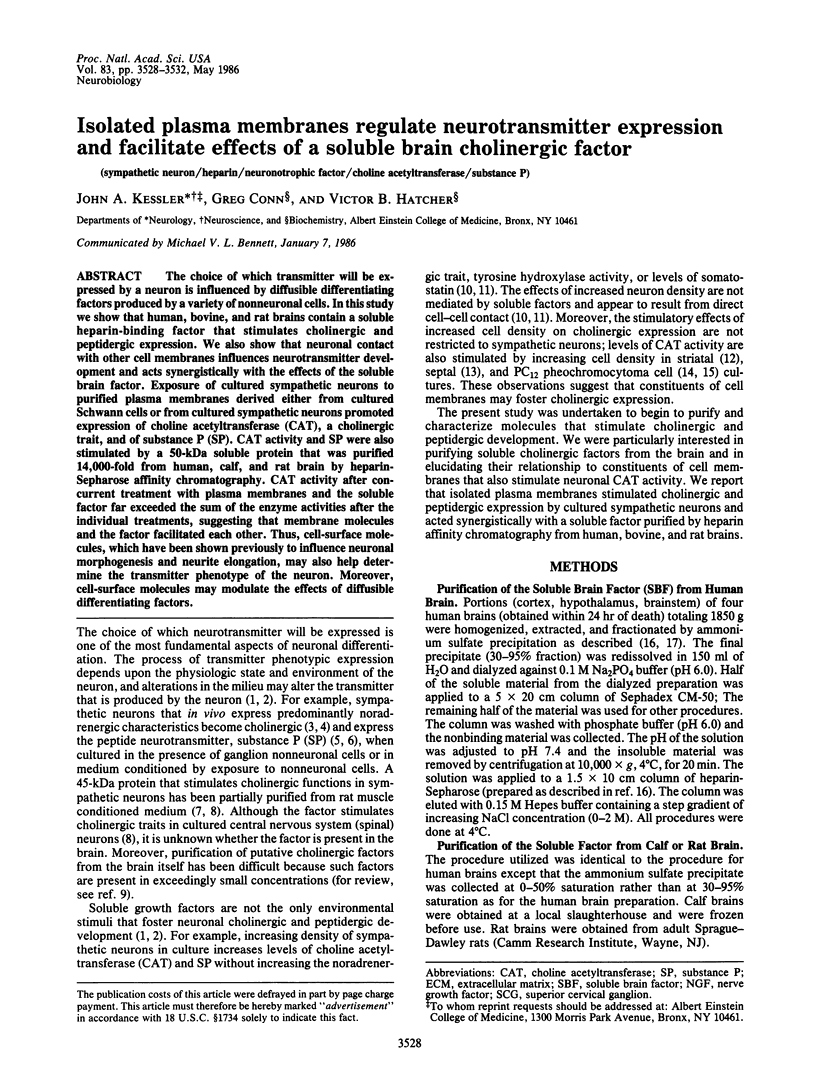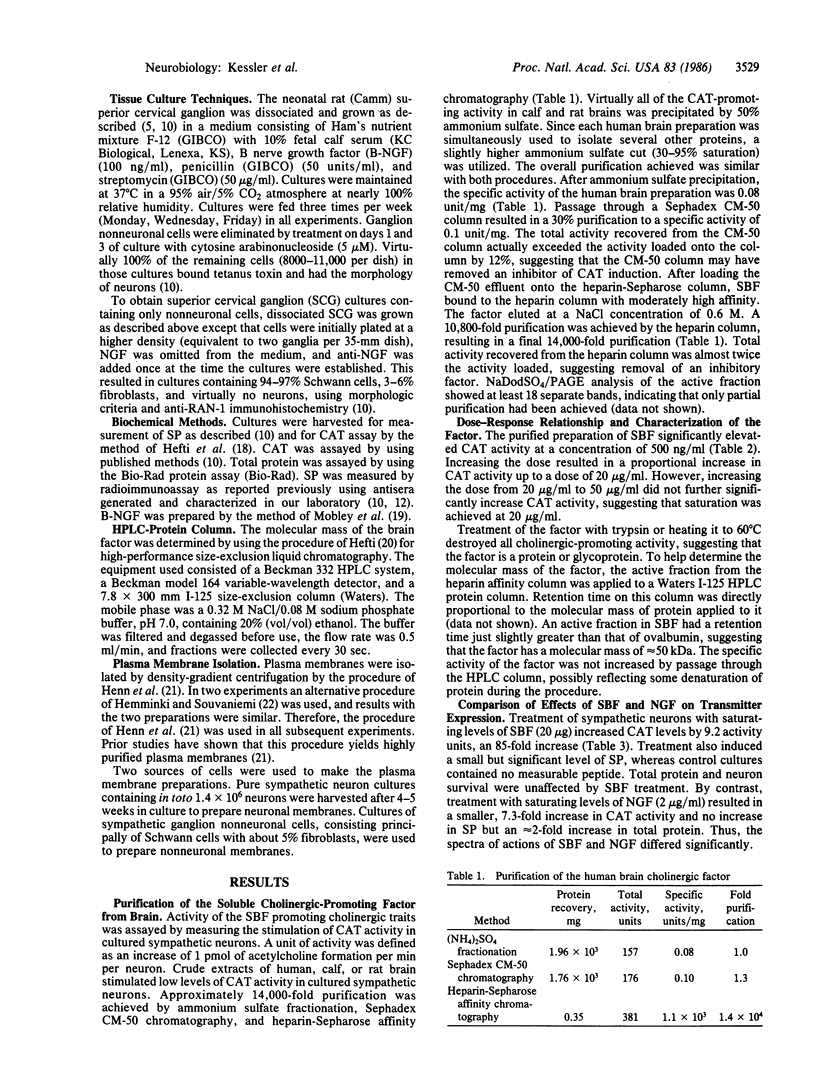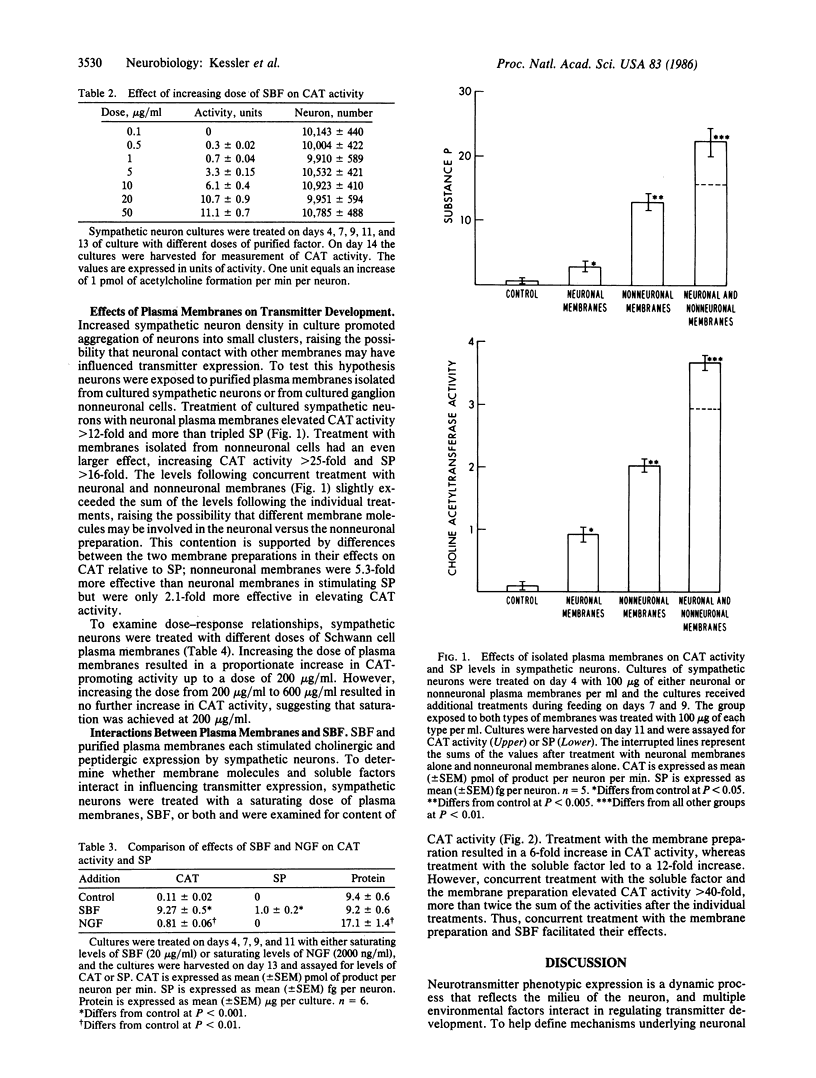Abstract
The choice of which transmitter will be expressed by a neuron is influenced by diffusible differentiating factors produced by a variety of nonneuronal cells. In this study we show that human, bovine, and rat brains contain a soluble heparin-binding factor that stimulates cholinergic and peptidergic expression. We also show that neuronal contact with other cell membranes influences neurotransmitter development and acts synergistically with the effects of the soluble brain factor. Exposure of cultured sympathetic neurons to purified plasma membranes derived either from cultured Schwann cells or from cultured sympathetic neurons promoted expression of choline acetyltransferase (CAT), a cholinergic trait, and of substance P (SP). CAT activity and SP were also stimulated by a 50-kDa soluble protein that was purified 14,000-fold from human, calf, and rat brain by heparin-Sepharose affinity chromatography. CAT activity after concurrent treatment with plasma membranes and the soluble factor far exceeded the sum of the enzyme activities after the individual treatments, suggesting that membrane molecules and the factor facilitated each other. Thus, cell-surface molecules, which have been shown previously to influence neuronal morphogenesis and neurite elongation, may also help determine the transmitter phenotype of the neuron. Moreover, cell-surface molecules may modulate the effects of diffusible differentiating factors.
Full text
PDF




Selected References
These references are in PubMed. This may not be the complete list of references from this article.
- Adler J. E., Black I. B. Sympathetic neuron density differentially regulates transmitter phenotypic expression in culture. Proc Natl Acad Sci U S A. 1985 Jun;82(12):4296–4300. doi: 10.1073/pnas.82.12.4296. [DOI] [PMC free article] [PubMed] [Google Scholar]
- Berg D. K. New neuronal growth factors. Annu Rev Neurosci. 1984;7:149–170. doi: 10.1146/annurev.ne.07.030184.001053. [DOI] [PubMed] [Google Scholar]
- Black I. B. Stages of neurotransmitter development in autonomic neurons. Science. 1982 Mar 5;215(4537):1198–1204. doi: 10.1126/science.215.4537.1198. [DOI] [PubMed] [Google Scholar]
- Bunge R., Johnson M., Ross C. D. Nature and nurture in development of the autonomic neuron. Science. 1978 Mar 31;199(4336):1409–1416. doi: 10.1126/science.24273. [DOI] [PubMed] [Google Scholar]
- Collins F., Dawson A. Conditioned medium increases the rate of neurite elongation: separation of this activity from the substratum-bound inducer of neurite outgrowth. J Neurosci. 1982 Aug;2(8):1005–1010. doi: 10.1523/JNEUROSCI.02-08-01005.1982. [DOI] [PMC free article] [PubMed] [Google Scholar]
- Conn G., Hatcher V. B. The isolation and purification of two anionic endothelial cell growth factors from human brain. Biochem Biophys Res Commun. 1984 Oct 15;124(1):262–268. doi: 10.1016/0006-291x(84)90946-x. [DOI] [PubMed] [Google Scholar]
- Duband J. L., Thiery J. P. Appearance and distribution of fibronectin during chick embryo gastrulation and neurulation. Dev Biol. 1982 Dec;94(2):337–350. doi: 10.1016/0012-1606(82)90352-9. [DOI] [PubMed] [Google Scholar]
- Edgar D. H., Thoenen H. Selective enzyme induction in a nerve growth factor-responsive pheochromocytoma cell line (PC 12). Brain Res. 1978 Oct 6;154(1):186–190. doi: 10.1016/0006-8993(78)91070-3. [DOI] [PubMed] [Google Scholar]
- Edgar D., Timpl R., Thoenen H. The heparin-binding domain of laminin is responsible for its effects on neurite outgrowth and neuronal survival. EMBO J. 1984 Jul;3(7):1463–1468. doi: 10.1002/j.1460-2075.1984.tb01997.x. [DOI] [PMC free article] [PubMed] [Google Scholar]
- Giess M. C., Weber M. J. Acetylcholine metabolism in rat spinal cord cultures: regulation by a factor involved in the determination of the neurotransmitter phenotype of sympathetic neurons. J Neurosci. 1984 Jun;4(6):1442–1452. doi: 10.1523/JNEUROSCI.04-06-01442.1984. [DOI] [PMC free article] [PubMed] [Google Scholar]
- Gordon P. B., Sussman I. I., Hatcher V. B. Long-term culture of human endothelial cells. In Vitro. 1983 Sep;19(9):661–671. doi: 10.1007/BF02628957. [DOI] [PubMed] [Google Scholar]
- Greene L. A., Rein G. Synthesis, storage and release of acetylcholine by a noradrenergic pheochromocytoma cell line. Nature. 1977 Jul 28;268(5618):349–351. doi: 10.1038/268349a0. [DOI] [PubMed] [Google Scholar]
- Hefti F., Gnahn H., Schwab M. E., Thoenen H. Induction of tyrosine hydroxylase by nerve growth factor and by elevated K+ concentrations in cultures of dissociated sympathetic neurons. J Neurosci. 1982 Nov;2(11):1554–1566. doi: 10.1523/JNEUROSCI.02-11-01554.1982. [DOI] [PMC free article] [PubMed] [Google Scholar]
- Hefti F., Hartikka J., Eckenstein F., Gnahn H., Heumann R., Schwab M. Nerve growth factor increases choline acetyltransferase but not survival or fiber outgrowth of cultured fetal septal cholinergic neurons. Neuroscience. 1985 Jan;14(1):55–68. doi: 10.1016/0306-4522(85)90163-0. [DOI] [PubMed] [Google Scholar]
- Hefti F. High-performance size-exclusion chromatography: a buffer for the reliable determination of molecular weights of proteins. Anal Biochem. 1982 Apr;121(2):378–381. doi: 10.1016/0003-2697(82)90496-1. [DOI] [PubMed] [Google Scholar]
- Hemminki K., Suovaniemi O. Preparation of plasma membranes from isolated cells of newborn rat brain. Biochim Biophys Acta. 1973 Feb 27;298(1):75–83. doi: 10.1016/0005-2736(73)90011-4. [DOI] [PubMed] [Google Scholar]
- Henn F. A., Hansson H. A., Hamberger A. Preparation of plasma membrane from isolated neurons. J Cell Biol. 1972 Jun;53(3):654–661. doi: 10.1083/jcb.53.3.654. [DOI] [PMC free article] [PubMed] [Google Scholar]
- Kessler J. A., Adler J. E., Bohn M. C., Black I. B. Substance P in principal sympathetic neurons: regulation by impulse activity. Science. 1981 Oct 16;214(4518):335–336. doi: 10.1126/science.6169153. [DOI] [PubMed] [Google Scholar]
- Kessler J. A., Black I. B. Regulation of substance P in adult rat sympathetic ganglia. Brain Res. 1982 Feb 18;234(1):182–187. doi: 10.1016/0006-8993(82)90485-1. [DOI] [PubMed] [Google Scholar]
- Kessler J. A. Differential regulation of cholinergic and peptidergic development in the rat striatum in culture. Dev Biol. 1986 Jan;113(1):77–89. doi: 10.1016/0012-1606(86)90109-0. [DOI] [PubMed] [Google Scholar]
- Kessler J. A. Differential regulation of peptide and catecholamine characters in cultured sympathetic neurons. Neuroscience. 1985 Jul;15(3):827–839. doi: 10.1016/0306-4522(85)90081-8. [DOI] [PubMed] [Google Scholar]
- Kessler J. A. Environmental co-regulation of substance P, somatostatin and neurotransmitter synthesizing enzymes in cultured sympathetic neurons. Brain Res. 1984 Oct 29;321(1):155–159. doi: 10.1016/0006-8993(84)90693-0. [DOI] [PubMed] [Google Scholar]
- Kessler J. A. Non-neuronal cell conditioned medium stimulates peptidergic expression in sympathetic and sensory neurons in vitro. Dev Biol. 1984 Nov;106(1):61–69. doi: 10.1016/0012-1606(84)90061-7. [DOI] [PubMed] [Google Scholar]
- Lander A. D., Fujii D. K., Gospodarowicz D., Reichardt L. F. Characterization of a factor that promotes neurite outgrowth: evidence linking activity to a heparan sulfate proteoglycan. J Cell Biol. 1982 Sep;94(3):574–585. doi: 10.1083/jcb.94.3.574. [DOI] [PMC free article] [PubMed] [Google Scholar]
- Le Douarin N. M. The ontogeny of the neural crest in avian embryo chimaeras. Nature. 1980 Aug 14;286(5774):663–669. doi: 10.1038/286663a0. [DOI] [PubMed] [Google Scholar]
- Loring J., Glimelius B., Weston J. A. Extracellular matrix materials influence quail neural crest cell differentiation in vitro. Dev Biol. 1982 Mar;90(1):165–174. doi: 10.1016/0012-1606(82)90222-6. [DOI] [PubMed] [Google Scholar]
- Mobley W. C., Schenker A., Shooter E. M. Characterization and isolation of proteolytically modified nerve growth factor. Biochemistry. 1976 Dec 14;15(25):5543–5552. doi: 10.1021/bi00670a019. [DOI] [PubMed] [Google Scholar]
- Patterson P. H., Chun L. L. The induction of acetylcholine synthesis in primary cultures of dissociated rat sympathetic neurons. I. Effects of conditioned medium. Dev Biol. 1977 Apr;56(2):263–280. doi: 10.1016/0012-1606(77)90269-x. [DOI] [PubMed] [Google Scholar]
- Patterson P. H. Environmental determination of autonomic neurotransmitter functions. Annu Rev Neurosci. 1978;1:1–17. doi: 10.1146/annurev.ne.01.030178.000245. [DOI] [PubMed] [Google Scholar]
- Pratt R. M., Larsen M. A., Johnston M. C. Migration of cranial neural crest cells in a cell-free hyaluronate-rich matrix. Dev Biol. 1975 Jun;44(2):298–305. doi: 10.1016/0012-1606(75)90400-5. [DOI] [PubMed] [Google Scholar]
- Tosney K. W. The early migration of neural crest cells in the trunk region of the avian embryo: an electron microscopic study. Dev Biol. 1978 Feb;62(2):317–333. doi: 10.1016/0012-1606(78)90219-1. [DOI] [PubMed] [Google Scholar]


